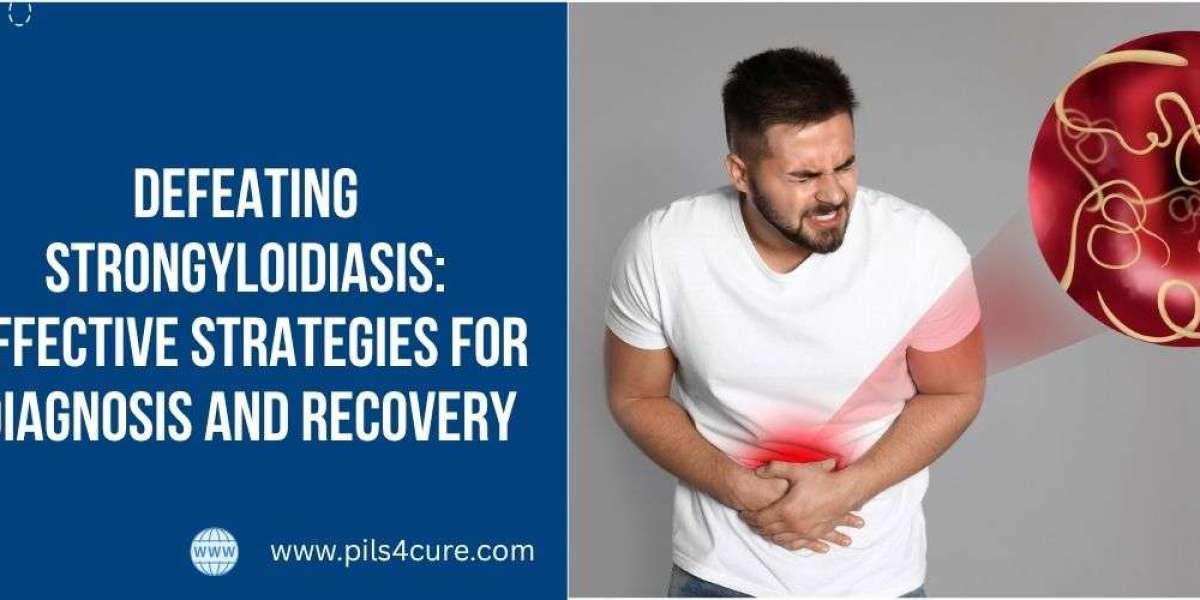Strongyloidiasis, an often-overlooked parasitic infection caused by the roundworm Strongyloides stercoralis, is quietly emerging as a growing public health concern in the United States. Although many people remain unaware of this disease, healthcare providers are reporting a slow but steady rise in cases, especially among vulnerable groups and individuals returning from regions where the infection is common. This detailed guide covers everything you need to know about strongyloidiasis disease from identifying early warning signs to exploring proven treatments such as ivermectin for strongyloidiasis, which remains the first-line therapy. Whether you are a medical professional, someone facing unexplained symptoms, or simply seeking knowledge about parasitic infections, this resource offers vital insights into one of the most underdiagnosed conditions in modern medicine.
What is Strongyloidiasis?
Strongyloidiasis is a chronic parasitic infection caused by Strongyloides stercoralis, a microscopic nematode (roundworm) that primarily affects the small intestine. Unlike many other parasitic infections, strongyloidiasis has a unique ability to persist and multiply within the human body for decades, making it particularly dangerous for immunocompromised individuals.
The infection occurs when larvae penetrate the skin, typically through bare feet walking on contaminated soil. Once inside the body, these parasites complete their complex life cycle, potentially causing a wide range of symptoms that can mimic other common conditions.
Understanding the Strongyloides Stercoralis Life Cycle
The Strongyloides stercoralis life cycle is remarkably complex and involves both free-living and parasitic phases:
Free-living Phase:
- Adult worms live in soil and reproduce sexually
- Eggs develop into infectious filariform larvae
- These larvae can survive in moist soil for extended periods
Parasitic Phase:
- Infectious larvae penetrate human skin
- They migrate through the bloodstream to the lungs
- Larvae travel up the respiratory tract and are swallowed
- They mature into adult females in the small intestine
- Female worms produce eggs that hatch into larvae
- Some larvae are expelled in feces, while others can re-infect the same host (autoinfection)
This unique autoinfection capability allows strongyloidiasis infection to persist for decades without re-exposure to contaminated soil.
Strongyloidiasis Symptoms: Recognizing the Warning Signs
Strongyloidiasis symptoms can vary dramatically between individuals and may develop weeks to years after initial infection. Many people remain asymptomatic for extended periods, making diagnosis challenging.
Early Strongyloides Symptoms
Skin Manifestations:
- Strongyloidiasis rash at the site of larval penetration
- Strongyloides skin rash appearing as red, itchy welts
- Linear, serpentine tracks on the skin (larva currens)
- Strongyloides symptoms rash that may come and go
- Skin hyper-sensitivity reactions
- Urticaria (hives) that doesn't respond to typical treatments
Respiratory Symptoms:
- Persistent cough, especially at night
- Wheezing and shortness of breath
- Chest pain and discomfort
- Pneumonia-like symptoms in severe cases
Gastrointestinal Strongyloidiasis Symptoms
- Abdominal pain and cramping
- Chronic diarrhea or alternating diarrhea and constipation
- Nausea and vomiting
- Bloating and excessive gas
- Unexplained weight loss
- Poor appetite
Systemic Symptoms
- Fatigue and weakness
- Low-grade fever
- Headaches
- Joint and muscle pain
- Eosinophilia (elevated white blood cells)
Risk Factors and Transmission
Several factors increase the risk of acquiring strongyloidiasis:
Geographic Risk:
- Travel to or residence in tropical and subtropical regions
- Areas with poor sanitation and sewage systems
- Rural communities with limited access to clean water
Behavioral Risk Factors:
- Walking barefoot on contaminated soil
- Agricultural work or gardening without protective footwear
- Contact with sewage or contaminated water
- Living in overcrowded conditions
Medical Risk Factors:
- Immunocompromised conditions (HIV/AIDS, organ transplants)
- Chronic corticosteroid use
- Cancer treatments affecting immune function
- Malnutrition
- Advanced age
Strongyloidiasis Treatment Options
Effective strongyloidiasis treatment requires proper diagnosis and appropriate antiparasitic medications. Treatment success depends on early detection and the patient's immune status.
Primary Treatment: Ivermectin for Strongyloidiasis
Ivermectin is considered the first-line treatment for strongyloidiasis:
- Standard Dosage: 200 micrograms per kilogram of body weight
- Duration: Typically administered daily for 1-2 days
- Follow-up: May require repeated courses for chronic infections
- Effectiveness: 90-100% cure rate in immunocompetent patients
Alternative Treatment Options
Albendazole:
- Used when ivermectin is unavailable or contraindicated
- Administered for 7-10 days
- Less effective than ivermectin but still beneficial
Thiabendazole:
- Older medication with more side effects
- Reserved for cases where other treatments fail
- Requires careful monitoring due to potential toxicity
Treatment Considerations for Special Populations
Immunocompromised Patients:
- May require prolonged treatment courses
- Regular monitoring for treatment response
- Higher risk of treatment failure and complications
Pregnancy:
- Ivermectin use requires careful risk-benefit assessment
- Alternative treatments may be considered
- Close medical supervision essential
Precautions and Prevention Strategies
Preventing strongyloidiasis infection requires awareness of risk factors and implementation of protective measures:
Personal Protection Measures
Footwear:
- Always wear shoes or sandals when walking outdoors
- Use waterproof footwear in potentially contaminated areas
- Inspect feet regularly for signs of larval penetration
Hygiene Practices:
- Wash hands thoroughly after soil contact
- Maintain proper personal hygiene
- Use clean water for drinking and washing
Travel Precautions:
- Research endemic areas before traveling
- Avoid walking barefoot in tropical regions
- Use insect repellent and protective clothing
Environmental Controls
Sanitation Improvements:
- Support proper sewage treatment systems
- Ensure safe water supplies
- Promote community health education
Agricultural Safety:
- Use appropriate protective equipment when farming
- Implement soil treatment programs where feasible
- Educate agricultural workers about infection risks
Diagnosis and Testing
Diagnosing strongyloidiasis can be challenging due to its varied symptoms and the intermittent shedding of larvae in stool samples.
Laboratory Tests
Stool Examination:
- Multiple samples may be required
- Specialized concentration techniques improve detection
- Fresh samples provide better results
Blood Tests:
- Eosinophilia may suggest parasitic infection
- Serological tests can detect antibodies
- IgG4 levels may be elevated
Advanced Diagnostic Methods:
- Strongyloides-specific antigen tests
- PCR testing for DNA detection
- Duodenal aspirate examination in difficult cases
Complications of Untreated Strongyloidiasis
Without proper treatment, strongyloidiasis can lead to serious complications:
Hyperinfection Syndrome
- Massive increase in parasite burden
- Occurs primarily in immunocompromised patients
- Can be life-threatening without immediate treatment
- May involve multiple organ systems
Disseminated Strongyloidiasis
- Parasites spread beyond the gastrointestinal tract
- Can affect lungs, liver, brain, and other organs
- Associated with high mortality rates
- Requires aggressive medical intervention
Secondary Bacterial Infections
- Migrating larvae can carry bacteria
- May lead to sepsis or meningitis
- Particularly dangerous in immunocompromised individuals
Living with Strongyloidiasis: Recovery and Long-term Management
Recovery from strongyloidiasis typically occurs within weeks of successful treatment. However, some patients may experience lingering symptoms as their body heals from chronic inflammation and tissue damage.
Post-Treatment Monitoring
- Follow-up stool examinations to confirm cure
- Blood tests to monitor eosinophil levels
- Assessment of symptom resolution
- Long-term surveillance in immunocompromised patients
Supporting Recovery
- Nutritional rehabilitation if malnutrition occurred
- Treatment of secondary bacterial infections
- Management of chronic symptoms
- Psychological support for anxiety related to chronic illness
Public Health Implications
The gradual increase in strongyloidiasis cases in the U.S. reflects several concerning trends:
Global Migration and Travel:
- Increased international travel to endemic regions
- Immigration from areas with high infection rates
- Military deployments in tropical locations
Climate Change Effects:
- Expanding geographic range of suitable habitats
- Changes in soil conditions affecting parasite survival
- Increased extreme weather events affecting sanitation
Healthcare Challenges:
- Limited awareness among healthcare providers
- Diagnostic difficulties leading to underreporting
- Need for improved screening programs
Frequently Asked Questions (FAQs)
Q: How long can strongyloidiasis remain dormant in the body?
A: Strongyloidiasis can remain asymptomatic for decades due to the parasite's ability to reproduce within the human body through autoinfection. Some cases have been documented 40-50 years after initial exposure, particularly in war veterans who served in endemic areas.
Q: Is strongyloidiasis contagious between people?
A: No, strongyloidiasis is not directly contagious from person to person. Transmission occurs only through contact with contaminated soil containing infectious larvae. The infection cannot spread through casual contact, sharing food, or respiratory droplets.
Q: Can strongyloidiasis be completely cured?
A: Yes, with proper treatment, strongyloidiasis can be completely cured in most cases. Ivermectin treatment has a 90-100% success rate in immunocompetent individuals. However, immunocompromised patients may require multiple treatment courses and long-term monitoring.
Q: How effective is ivermectin for strongyloidiasis treatment?
A: Ivermectin is highly effective for treating strongyloidiasis, with cure rates exceeding 90% in most studies. It's considered the gold standard treatment due to its excellent efficacy and relatively mild side effect profile compared to older medications.
Q: What does a strongyloides rash look like?
A: Strongyloides skin rash can appear in several forms: red, itchy welts at penetration sites, linear serpentine tracks (larva currens) that move rapidly across the skin, or generalized urticaria (hives). The rash may be intermittent and is often mistaken for other skin conditions.
Q: How is strongyloidiasis different from other parasitic infections?
A: Strongyloidiasis is unique because of its ability to cause autoinfection, allowing the parasite to multiply and persist within the same host for decades without re-exposure. This characteristic makes it particularly dangerous and difficult to diagnose compared to other intestinal parasites.
Q: Can pets transmit strongyloidiasis to humans?
A: While dogs and cats can be infected with related Strongyloides species, Strongyloides stercoralis is primarily a human parasite. However, contaminated soil from infected animals in endemic areas could theoretically pose a transmission risk.



